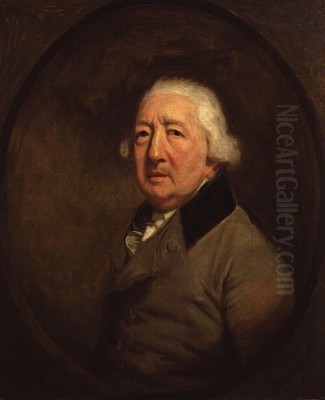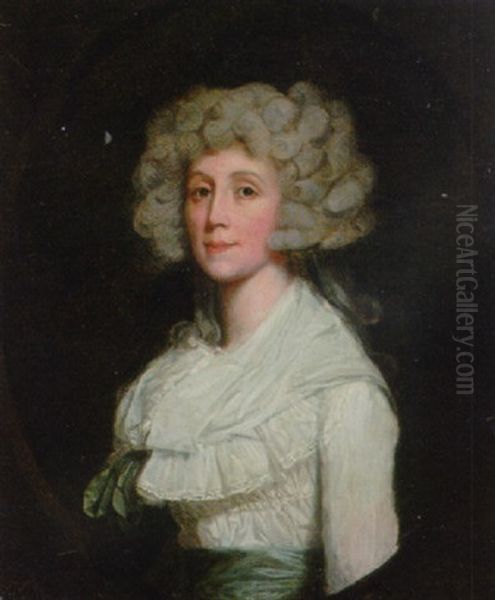
Thomas Beach stands as a notable figure in the landscape of 18th-century British art. A dedicated portrait painter, his career unfolded during a vibrant period often referred to as the Golden Age of British Painting. Born in 1738 and passing away in 1806, Beach navigated an art world dominated by titans, yet carved out a respectable niche for himself, primarily serving patrons outside the immediate orbit of London's most fashionable studios. His nationality was unequivocally British, specifically English, and his work provides valuable insight into the society and artistic tastes of his time.
Early Life and Artistic Formation
Thomas Beach was born in Milton Abbas, Dorset, in 1738. Details about his earliest years and initial inclination towards art are somewhat scarce, a common reality for artists not born into established artistic or aristocratic families. However, his talent must have been evident relatively early on. A pivotal moment in his development came when he moved to London to pursue formal artistic training.
Crucially, from 1760 to 1762, Beach became a pupil of the most celebrated portrait painter of the age, Sir Joshua Reynolds. This period of study was immensely formative. Reynolds was not only the first President of the Royal Academy but also the leading proponent of the 'Grand Manner' in portraiture, advocating for idealized representations that elevated the sitter through classical allusions and sophisticated compositions. Studying under Reynolds provided Beach with invaluable technical skills, insights into composition, colour theory, and, importantly, exposure to the workings of a highly successful metropolitan studio. He also likely studied at the St Martin's Lane Academy, a precursor to the Royal Academy Schools and a hub for artistic learning in London.
Establishing a Career in Bath
After his training under Reynolds, Beach did not immediately attempt to establish himself in the fiercely competitive London market. Instead, he made the strategic decision to move to the fashionable spa town of Bath. This proved to be an astute choice. Bath, during the mid-to-late 18th century, was a major social centre, attracting wealthy visitors seeking health cures, entertainment, and social interaction. This transient and resident affluent population created a significant demand for portraiture.

In Bath, Beach established a successful practice that lasted for many years. He became the city's leading resident portraitist after the departure of Thomas Gainsborough, another giant of British painting who had also found success there earlier. Beach's studio attracted a steady stream of clients, including local gentry, prosperous merchants, visiting aristocrats, and notable figures from the city's vibrant cultural life. His ability to capture a strong likeness, combined with the solid technical grounding received from Reynolds, ensured his popularity.
Artistic Style and Influences
Thomas Beach's style is firmly rooted in the traditions of 18th-century British portraiture, with the influence of his master, Sir Joshua Reynolds, being paramount. This is evident in his compositional structures, the often formal poses of his sitters, and his use of a rich, though perhaps less layered, palette compared to Reynolds. He aimed for a dignified representation, capturing the status and character of his subjects.
However, Beach was not merely an imitator. His work often displays a certain directness and robustness that distinguishes it from the more overtly flattering or idealized approach sometimes seen in Reynolds's output. Beach seems less concerned with classical grandeur and more focused on achieving a convincing and characterful likeness. His brushwork is generally competent and controlled, lacking the fluid, feathery touch of Thomas Gainsborough or the sometimes dramatic flair of George Romney.
Compared to contemporaries like the Scottish master Allan Ramsay, known for his elegant and sensitive portrayals, or the meticulous Joseph Wright of Derby, famed for his dramatic use of light, Beach's style appears more straightforwardly representational. He operated within the established conventions of the time but brought his own slightly plainer, more grounded sensibility to the genre. His work sits comfortably within the mainstream of Georgian portraiture, valued for its reliability and accuracy.
Notable Works and Sitters
Throughout his career, Thomas Beach painted a wide array of individuals. One of his well-documented works is the portrait of John Montagu, 4th Earl of Sandwich. This painting, depicting the prominent politician and reputed inventor of the sandwich, showcases Beach's ability to handle formal portraiture, capturing the sitter's status and personality. The work is housed at Hinchingbrooke House, historically associated with the Montagu family.
Beach was also known for his portraits of figures from the theatrical world, which was flourishing in London and Bath. He painted several likenesses of the celebrated actress Sarah Siddons, capturing the dramatic intensity for which she was renowned. His portraits of actors like John Henderson and William Powell further demonstrate his connection to the stage. These theatrical portraits often allowed for slightly more dynamic poses and expressions than his commissions from the gentry.

Other significant works include portraits of professionals and intellectuals, such as William Woodfall, the parliamentary reporter and publisher, known for his remarkable memory. He also painted numerous members of the West Country gentry and clergy, documenting the local elites of Dorset, Somerset, and Wiltshire. These portraits, while perhaps less famous internationally, form a valuable record of provincial society during the Georgian period. His group portrait The Family of Sir William Medows is another example of his skill in handling more complex compositions.
Professional Life and Exhibitions
Thomas Beach maintained connections with the London art world despite being based primarily in Bath and later Dorchester. He understood the importance of exhibiting his work to gain wider recognition and attract patrons. He was a regular contributor to the major public exhibitions of his day.
He exhibited frequently with the Society of Artists, an important exhibiting body established before the Royal Academy. From 1771 until 1783, he sent works there consistently. Following this, he began exhibiting at the prestigious Royal Academy of Arts in London, showing works there from 1785. His participation in these exhibitions demonstrates his ambition and his desire to be judged alongside the leading artists of the day, including his former master Reynolds, and rivals like Gainsborough, Romney, and the up-and-coming portraitists such as John Hoppner and Sir Thomas Lawrence.
While not elected a full member of the Royal Academy, his consistent presence at its exhibitions indicates a level of respect within the artistic community. He was also a member of the Incorporated Society of Artists, serving as its Vice-President for a time, further highlighting his engagement with the institutional structures of the British art world.
Contemporaries and the Artistic Landscape
The late 18th century was a period of extraordinary talent in British painting, particularly in portraiture. Thomas Beach worked alongside and often in competition with some of the greatest names in British art history. Sir Joshua Reynolds and Thomas Gainsborough were the undisputed leaders, commanding the highest prices and prestige, particularly in London. George Romney emerged as a fashionable rival, known for his elegant and sometimes more psychologically penetrating portraits.
In Scotland, Henry Raeburn was developing his distinctive, bold style. Johann Zoffany excelled in conversation pieces and theatrical subjects, genres Beach also touched upon. Joseph Wright of Derby, while based in the Midlands, gained fame for his unique depictions of science and industry, alongside his portrait work. Francis Cotes was another prominent portraitist, particularly successful in pastels as well as oils, until his early death in 1770.
Later in Beach's career, younger artists like John Hoppner and Sir Thomas Lawrence rose to prominence, inheriting the mantle of leading portraitists into the Regency era. Women artists also achieved success, notably Angelica Kauffman and Mary Moser, both founding members of the Royal Academy, specializing in history painting and flower painting respectively, though Kauffman also undertook portraiture. Beach navigated this crowded field by cultivating a strong regional practice, offering solid, reliable portraits often at more accessible prices than the London stars. While perhaps lacking the innovative genius or fashionable allure of some contemporaries, his craftsmanship and ability to capture likeness secured him a long and productive career.
Later Years and Legacy
In 1797, nearing the age of sixty, Thomas Beach retired from his busy practice in Bath and returned to his native Dorset, settling in Dorchester. However, retirement did not mean complete cessation of work. He continued to paint, undertaking commissions for local patrons and remaining active in his final years. He passed away in Dorchester on December 17, 1806.
Thomas Beach's legacy is that of a skilled, diligent, and highly productive portrait painter who made a significant contribution to British art outside the primary centre of London. While perhaps overshadowed by the towering figures of Reynolds and Gainsborough, his work is essential for understanding the breadth and depth of Georgian portraiture, particularly in the West Country. He faithfully recorded the likenesses of a generation of aristocrats, gentry, professionals, and theatrical figures.
His paintings are valued for their strong characterization, solid technique, and historical significance as documents of the people and society of his time. He represents the capable professional artist who sustained a successful career through talent, hard work, and a good understanding of his market, providing a vital service in an era when painted portraits were the primary means of recording appearance and status.
Collections and Where to See His Work
Works by Thomas Beach can be found in numerous public and private collections, primarily in the United Kingdom. The National Portrait Gallery in London holds several of his portraits, including those of notable figures like William Woodfall and possibly Sarah Siddons (though attributions can sometimes be debated). Tate Britain also includes his work in its collection.
Many of his portraits remain in regional museums and galleries, particularly in the West of England, reflecting his strong connections to Bath and Dorset. Institutions like the Victoria Art Gallery in Bath, the Bristol Museum & Art Gallery, and the Dorset County Museum may house examples of his work. As mentioned earlier, the portrait of the 4th Earl of Sandwich is at Hinchingbrooke House in Cambridgeshire. Numerous other portraits are likely still held in the family collections of the descendants of his sitters, residing in country houses across Britain. His work occasionally appears on the art market, offered by auction houses and dealers specializing in British paintings.
Conclusion
Thomas Beach occupies a respected place in the annals of British art history. As a pupil of Reynolds, he absorbed the core tenets of the dominant style of his age, but developed his own distinct, somewhat more direct approach to portraiture. His strategic choice to base himself in Bath allowed him to build a thriving practice away from the intense competition of London, serving a clientele eager for likenesses rendered with competence and character. Through his numerous portraits, Beach provided a valuable visual record of Georgian society, capturing the faces of the era with skill and diligence. While not an innovator on the scale of Reynolds or Gainsborough, he was a talented and significant artist whose contributions enriched the artistic landscape of 18th-century Britain. His paintings continue to be appreciated for their historical insight and their solid, unpretentious artistry.